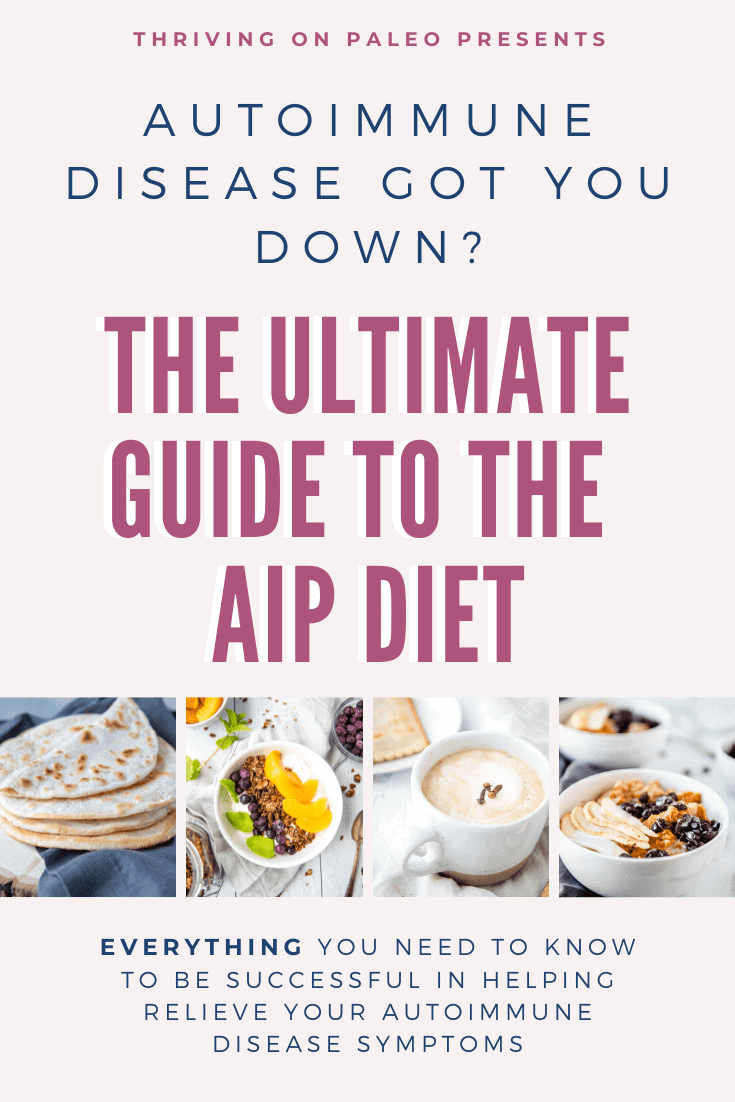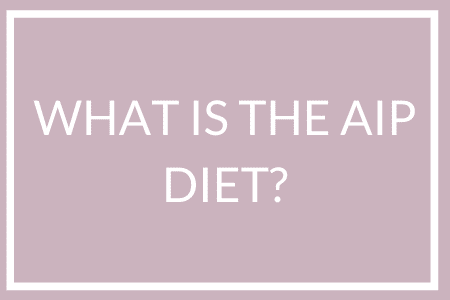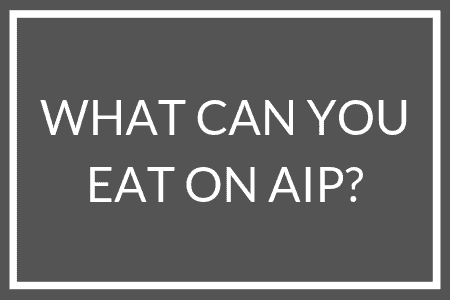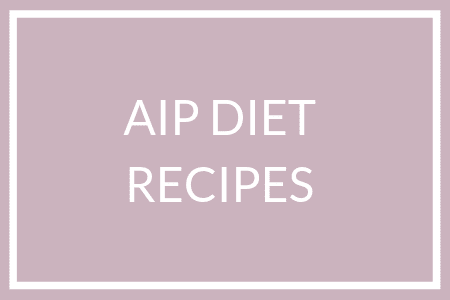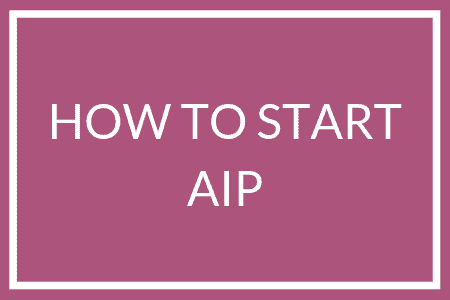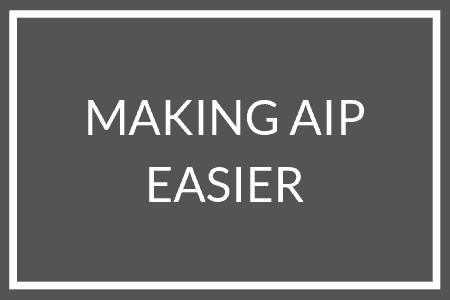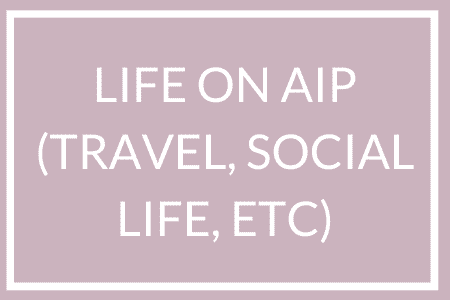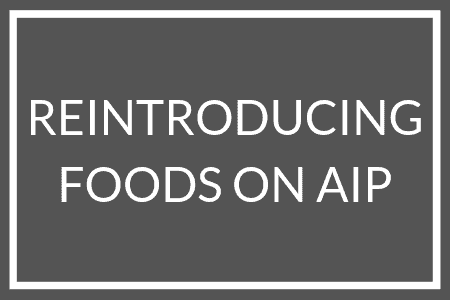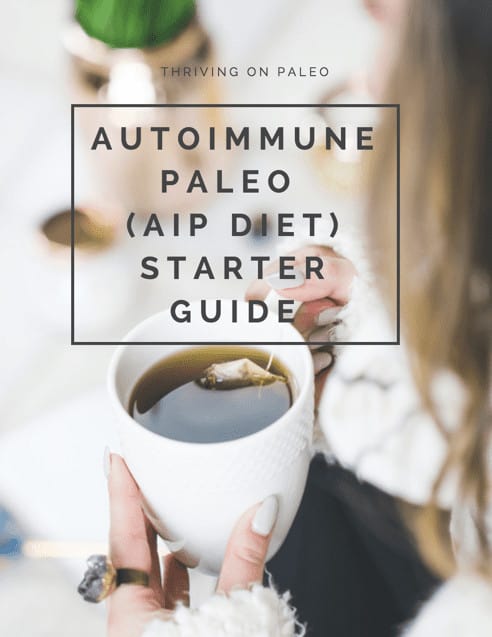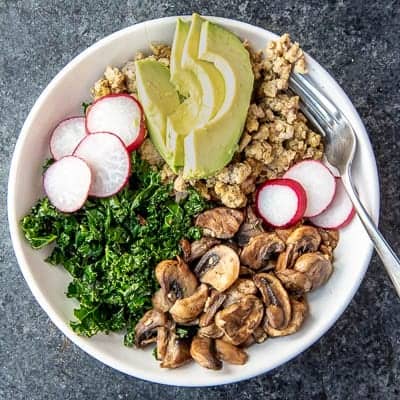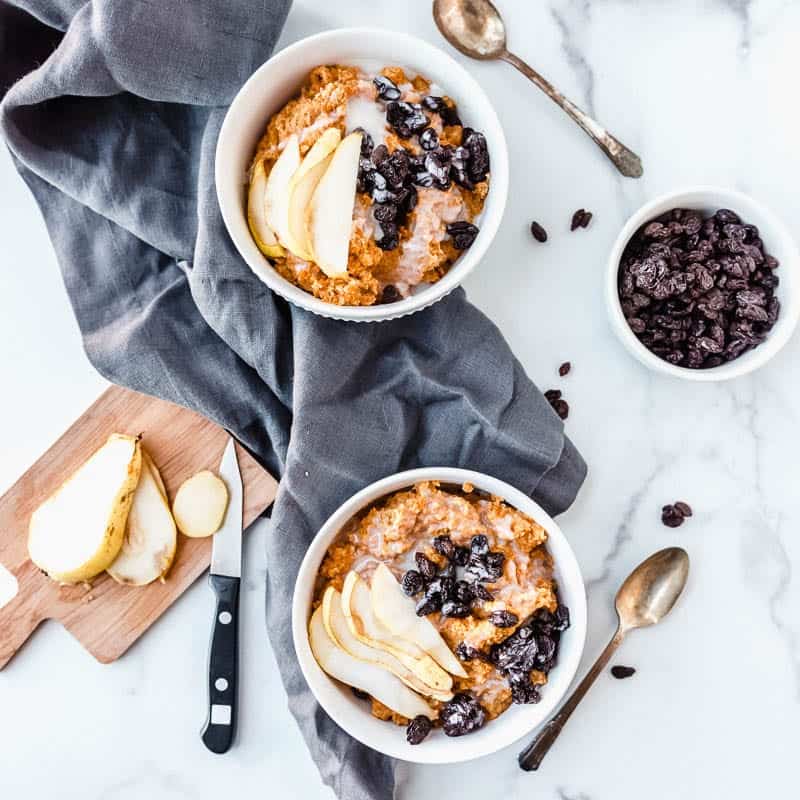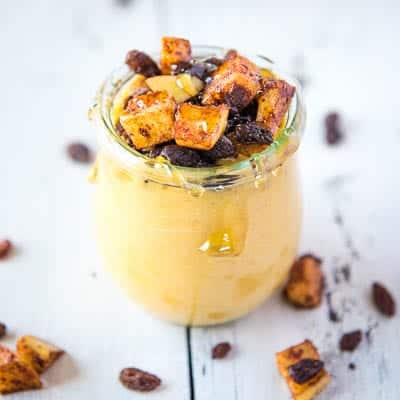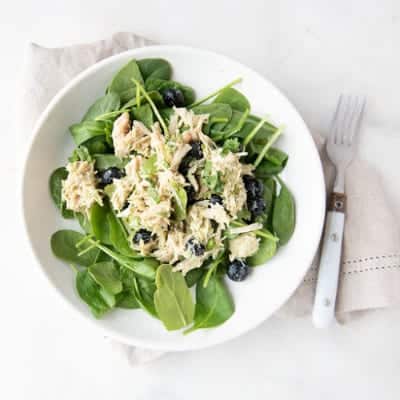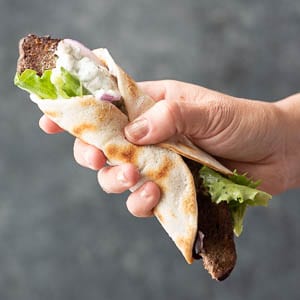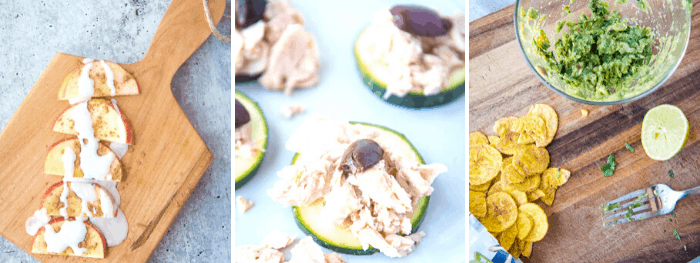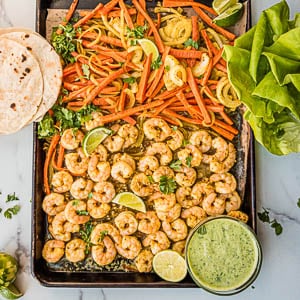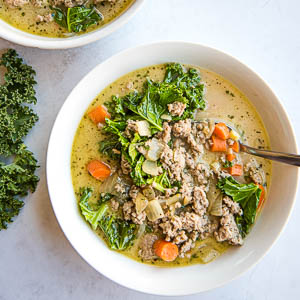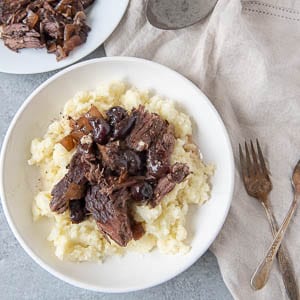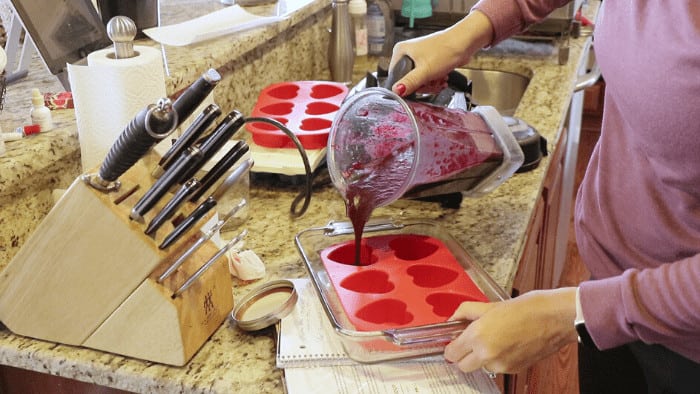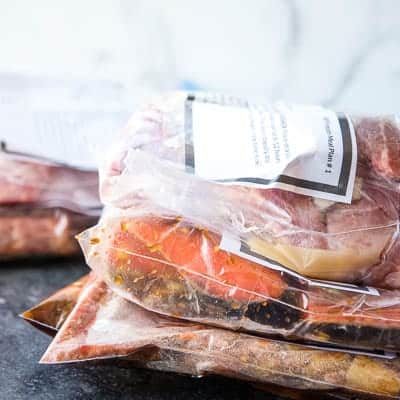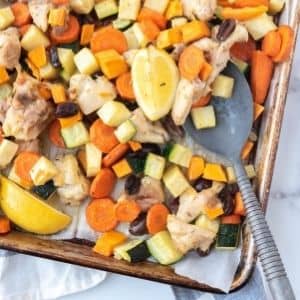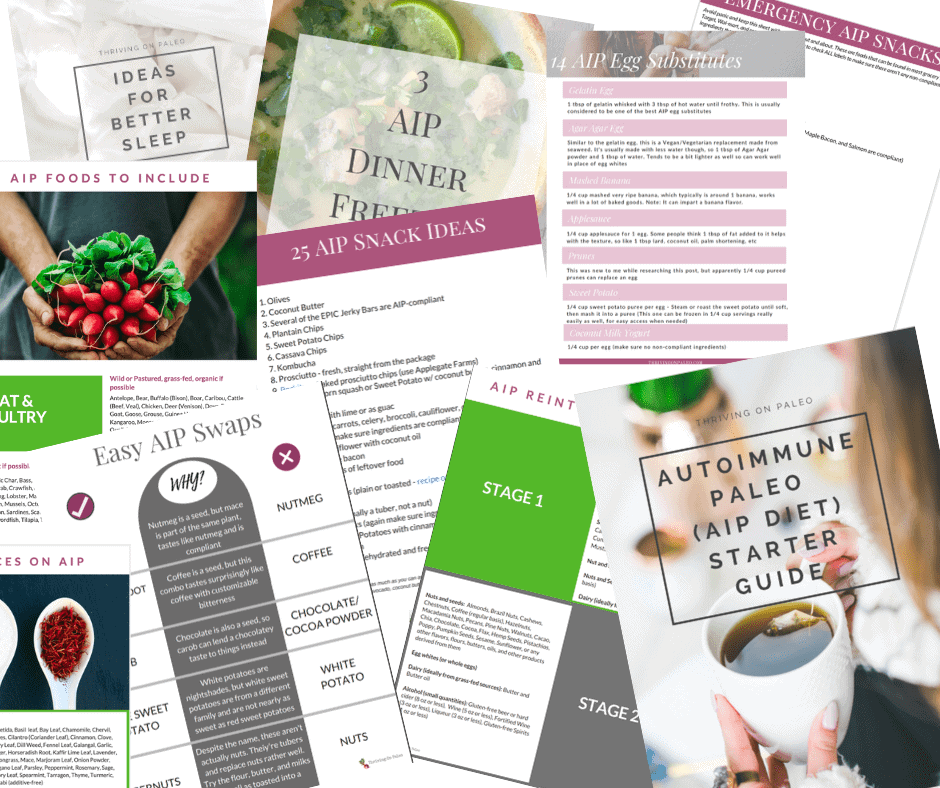AIP Diet
EVERYTHING you need to know about the Paleo Autoimmune Protocol, aka, the AIP Diet, to be successful and thrive! (And don't worry, it's not as hard as it may seem. I'll show you how to make it a lot easier and delicious at the same time)What do you WANT TO SEE?
Either scroll down to read everything about the AIP Diet in order or click on any of the images below to be taken directly to that spot on this page.
What is the AIP Diet?
If your quality of life is suffering because of your autoimmune disease symptoms, read on!
The AIP Diet is a temporary healing elimination and reintroduction strategy specifically for those with autoimmune disease.
It's also known as the Autoimmune Protocol, Autoimmune Paleo Protocol, or Paleo Autoimmune Protocol.
AIP is an effective tool that can be used in conjunction with lifestyle changes to help bring about relief from symptoms and has two parts – food and lifestyle.
The Food Part
The main idea of the diet is to:
- Remove foods proven by scientific studies to commonly be problematic for those with autoimmune disease
- Add in nutrient-dense foods that will help replenish your body and allow you to heal (which means relief from your symptoms!)
These potentially problematic foods are removed for a temporary period of time (the elimination diet part), typically for 30-90 days.
Then they're systematically reintroduced one-by-one to uncover any remaining food intolerances that may prevent full healing.
This gives your body a rest from constant immune stimulation and allows it to:
• reduce inflammation
• heal a leaky gut
• and calm your immune system down to work properly
In the end, you've got a highly customized diet that works best for YOU.
Note: Calories are not restricted on the Autoimmune Protocol, so this is NOT one of those starvation-type diets. Phew, thankfully!
The Lifestyle Part
Along with the diet, lifestyle factors are also very important.
These include:
• getting at least 8-9 hours of sleep at night
• ongoing stress relief
• adequate exercise
• mental/emotional aspects like letting go of the anger and resentment you may have towards your disease
Oftentimes these lifestyle factors are overlooked or considered to be optional, but they aren't.
You'll find that even if you get your disease under control, too much stress, not enough sleep, or too much exercise can cause a flare-up of your symptoms.
Therefore it's best if you can make these lifestyle changes as soon as possible for long-term, lasting relief!
The Version of AIP I Talk About
There are a few versions of the AIP Diet floating about, but the one I talk about on is the Paleo Autoimmune Protocol.
This version was developed by Dr. Sarah Ballantyne and is a subset of the Paleo Diet.
The rest of this page explains EVERYTHING you need to know.
WAnt the cliff notes?
If you want a short and concise Cliff Notes-version of “What is the AIP Diet” – get the password to my Paleo & AIP Freebie library to grab this AIP Diet Starter Guide (and so much more).
In this guide learn:
- What the Autoimmune Paleo Protocol (AIP Diet) is
- Why it's so effective for helping with symptoms
- What the diet is (what you can and cannot have)
- Lifestyle tips, hacks, and ideas
- How to best implement the diet
- Things you need to start the diet
- Some easy swaps
- Several delicious recipes (including a pancake recipe! yum)
After reading this guide you'll be well equipped to make a decision on whether you'd like to try this super-effective way of eating and feel armed with the knowledge that will make you successful. It's FREE inside the Paleo & AIP Freebie Library
WhO IS The AIP DIET FOR?
I get asked a lot “Should I do AIP”?
The answer definitely can vary depending on how you feel, how much experience you've had with a restrictive diet like Paleo, GAPS or Whole30, and whether you'll be able to follow the diet due to lifestyle factors like a crazy busy job or family life.
You SHOULD NOT DO AIP (Yet) IF:
I typically recommend that you NOT try the AIP Diet just yet if you:
• aren't feeling all that bad
• just have a few annoying autoimmune symptoms
• haven't tried any restrictive diets at all and are feeling completely intimidated and overwhelmed by the whole idea
• are currently experiencing extremely busy or stressful temporary circumstances – major job deadline, major illness in a family member that you're taking care of, cross country move, etc
This isn't to say that you CAN'T do AIP with any of these – I've had plenty of clients who have successfully done it with ALL of these, but it may be easier to do gluten-free or Paleo instead for the time being and see if either of those diets help you to feel better.
And if you aren't feeling bad or have few symptoms, Paleo may be all you need to feel much better!
AIP May BE FOR YOU IF:
On the other hand, AIP might be for you if your:
• quality of life is suffering
• symptoms are constant and debilitating
• life is being put on hold – you miss events, work, things your family and friends are doing, etc
• feeling is that enough is enough!
What CAN YOU EAT ON THE AIP DIET?
If someone told you you could stop feeling miserable from your symptoms by eating a wide variety of delicious and colorful fruits and vegetables, meats, seafoods, and fats, what would you think?
Please keep an open mind when looking at this section. Many people tend to freak out when they look the food lists because many of the foods they're accustomed to are not allowed on the diet.
Because, yes, the AIP Diet is restrictive when compared to a Standard American Diet.
However, if you look at it from the other way – that you GET to eat a whole bunch of fruits, veggies, meats, seafoods, and fats, it's really quite abundant.
Plus, remember, this is a temporary diet, not a life sentence.
WHY YOU ELIMINATE FOODS
The foods on the Paleo Autoimmune Protocol are meant to be anti-inflammatory, promote gut healing, and help calm the immune system so it no longer attacks your own tissue.
They're basically giving your body a much-needed break and replenishing it with much-needed nutrients.
THE PROCESS
First, you remove the foods from the NO list for the entire portion of the elimination diet (typically 30-90 days).
Then you reintroduce them one-by-one once you've started to feel better.
The exact reintroduction process and schedule are discussed below in the Reintroduction section.
YES and no Foods
You can read all of the specifics of exactly what foods you can and can't eat in my post AIP Food List, but the basic idea is:
YES
Meats & Poultry
Fish & Seafood
Leafy Greens
Most Vegetables
Roots & Tubers
Sea Vegetables
Berries
Melons
Many Fruits
Most Mushrooms
Animal Fats
Plant Fats
Fermented Foods
Some Spices
A few Sweeteners
Other flavor elements
NO
Grains
Pseudo-Grains
Dairy
Legumes/Beans
Processed Vegetable Oils
Added Sugars
Processed Food Chemicals & Ingredients
Sugar Alcohols
Artificial Sugars
Nuts and Nut Oils
Seeds, Seed Oils, Seed Spices
Coffee
Chocolate
Nightshades and Nightshade Spices
Eggs
Alcohol
A few other items like Baking Powder, Maca, Slippery Elm, Aloe Vera, Black Pepper, etc
Usually people have the hardest time mentally with the elimination of coffee, eggs, and chocolate. But remember – it's a temporary diet and if all goes well, you'll be able to have them all again soon.
See below though for a bunch of coffee alternatives, an easy swap for chocolate, and 14 substitutions for eggs in baking.
Again, the full specifics of the foods you can and cannot eat can be found at the AIP Food List post.
WHAT IF I KNOW I DON'T REACT TO AN ELIMINATED FOOD?
I get this question ALL the time, and the answer is, you should still eliminate it. You may THINK you don't have an issue with it, but you might be surprised.
Take me for instance, I ate gluten for 36 years and never thought I had an issue with it. After removing it from my diet for 6 months I had some soy sauce (which contains gluten) and had the WORST, most painful night of my life.
Every time I've accidentally gotten exposed to gluten ever since has been miserable.
And then when I did the AIP Diet for the first time I couldn't reintroduce paprika for a year without getting mild depression for a few days after. I'm not even sure there are any food sensitivity tests out there for paprika, so the only way I'd ever have known was to remove it for a while. (I can now eat it without any issues after months of healing)
So, while you think you might be able to get by with eating something, if you truly want to KNOW, it's best to take the recommended foods out for at least 30 days.
AIP SPICES
Spices can be a tricky item on AIP.
Because you eliminate nightshades, things like cayenne pepper, chili powder, chipotle pepper, curry powder, paprika, crushed red pepper, and store-bought taco seasoning are out.
Also, because seeds are eliminated, cumin, caraway, cardamom, fennel seed, mustard, and poppy seed spices (along with other seed-based spices) are out.
And then a few fruit- and berry-based spices are also eliminated as well, including black pepper and allspice.
But you aren't sentenced to months of bland food.
You CAN have cinnamon, cloves, ginger, and turmeric as spices on AIP, along with a whole host of herbs to give your food flavor.
It's all about learning to cook a bit differently than you're probably used to, but foods on AIP can easily be delicious.
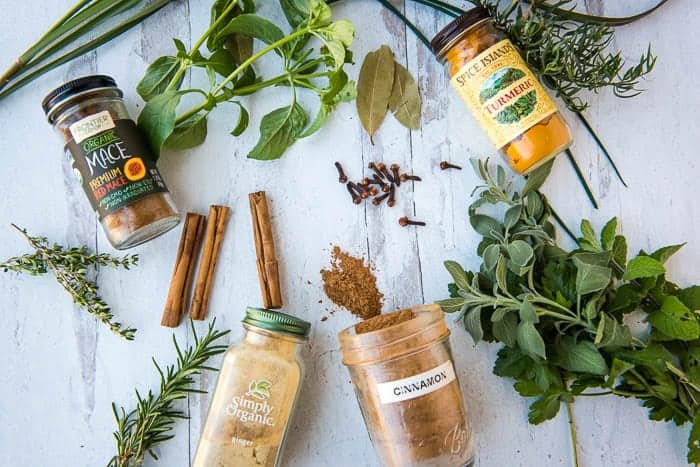
Want to know more about herbs and spices allowed on AIP as well as how to use them to flavor your dishes? Visit my post on AIP Spices which will help clear it all up for you.
COMMON AIP FOODS
Some of the ingredients on AIP can seem a little strange and foreign as we've had to get creative to get around not having some of the common ingredients most people use.
Things like tigernuts, cassava flour, dandelion root, mace, carob powder, etc may be completely unfamiliar to you even if you've been following a Paleo-style diet for years.
Quick Fact: Tigernuts aren't nuts – they're actually small tubers!
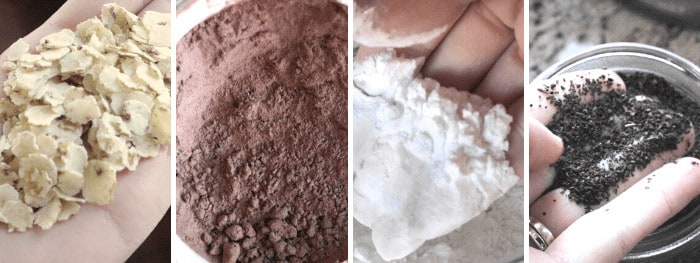
These ingredients can help you make a whole list of yummy dishes though, from granola to breads to coffee substitutes, and even to amazing desserts.
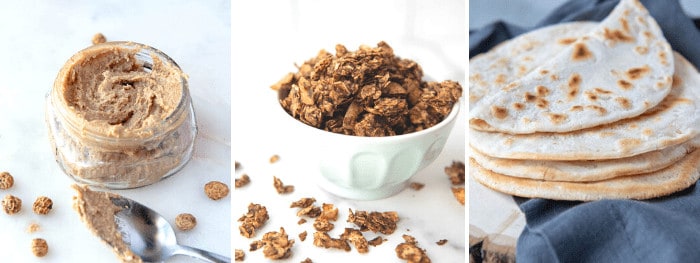
Once you've gotten to know these ingredients they can really help you replace some of the foods you might be missing.
Plus, half the fun of doing AIP is discovering new foods!
To familiarize yourself with these, check out the Common AIP Foods.
And you can also learn more about common AIP flours.
EASY AIP SWAPS
Now that you are familiar with some of the more common AIP ingredients, it's also important to understand some easy AIP swaps for foods you might be craving.
These are ingredients you can swap for ones you may be used to.
Here are just a few:
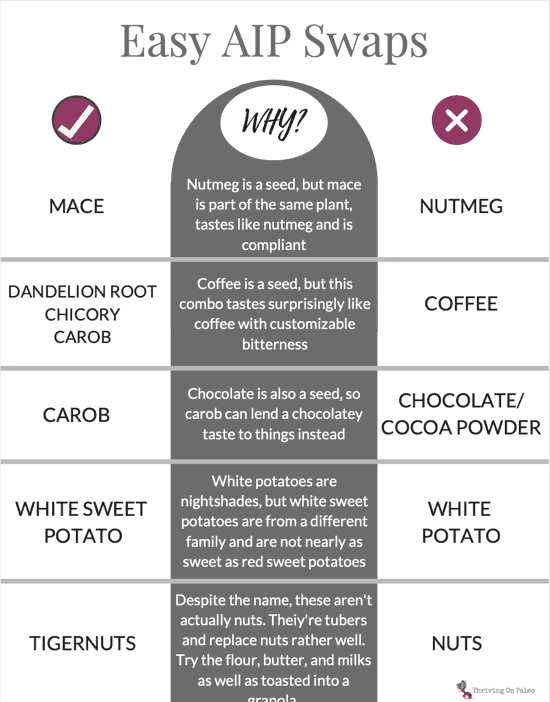
A lot of the AIP Diet is just relearning how to eat certain things – and where to find them. This might seem daunting at first, but once you get used to it, it's really not bad.
Some things you just replace one-for-one for a familiar ingredient, like coconut milk for cow's milk. (See how to make homemade coconut milk) or tigernut butter for nut butter.
Others you may have to make some adjustments for how you're used to using them, but you may find them becoming a new favorite.
For example, my popular “Chocolate” AIP Granola recipe is absolutely delicious, made primarily of sliced tigernuts, and a recipe that many people still continue to eat when they transition off of AIP.
Learn about a ton more easy AIP Swaps.
Can I have coffee on aip?
Unfortunately, the answer is no, you shouldn't drink it if you want to stick to the elimination diet the way it's designed.
Why? Because coffee is a seed, and seeds are eliminated on the Autoimmune Protocol.
However, AIP is not a caffeine-free protocol, so you can still have caffeine via things like black and green tea.
Just watch how much you drink, as too much caffeine can mess with your hormones and cause sugar cravings. You're trying to fix these by going on AIP.
Some Coffee Alternatives
Don't lose hope for a comforting warm beverage in the morning though. There are MANY things you can drink instead!
Some ideas?
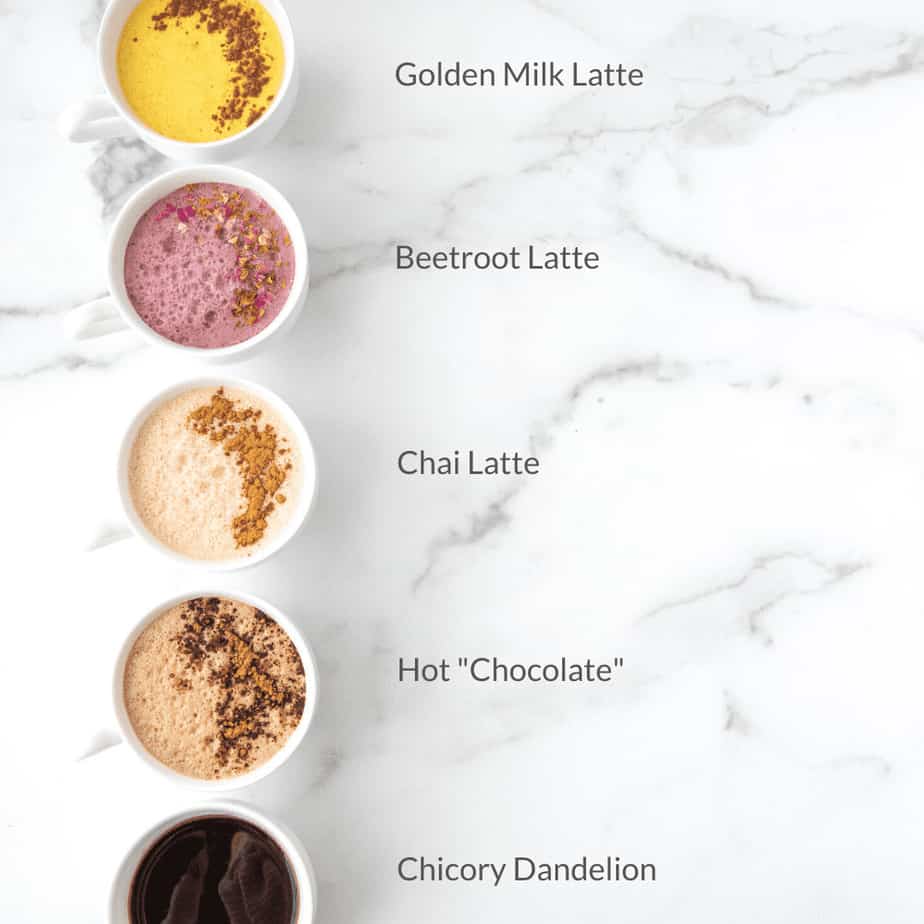
These are just some of the coffee alternatives. You can see the recipes for these and more in the post: AIP Coffee Alternatives
AIP Recipes
Now that you're familiar with the foods you can eat while on AIP, you probably want to know what some of the MEALS look like, right? Well, here ya go:
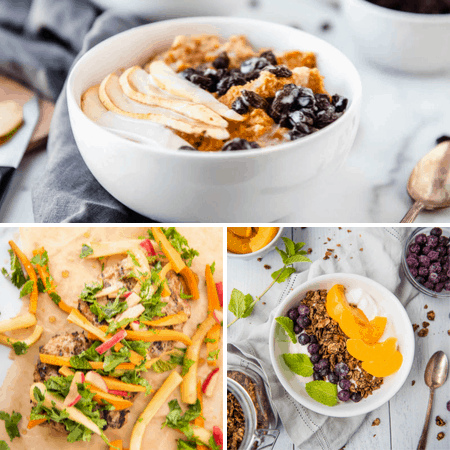
All of the AIP Recipes I've published here on Thriving On Paleo can be found in the AIP Recipe Gallery. These recipes are all AIP-compliant, nightshade-free, nut-free, seed-free, dairy-free, but also delicious!
AIP BREAKFAST Recipes
The MOST confusing meal on the Autoimmune Protocol is usually breakfast.
Why?
Because you can't have eggs or grains. So most of the common breakfast foods you're used to aren't allowed.
However, don't despair! There are plenty of delicious things you can eat while on AIP.
Typically you just need to rethink what breakfast is.
Instead of cereal or eggs and pancakes, you might eat a nutrient-dense soup or leftovers from the night before.
You may have to experiment a bit to see what you like. I learned early on that I do NOT like fish first thing in the morning (blech!) but absolutely adore soup. You might be the opposite!
Here are a few ideas to get you started:
See 10 AIP Breakfast Ideas for even more ideas!
AIP LUNCH Recipes
Lunch can also be harder to figure out if you need portable lunches that don't have to be reheated. Otherwise, leftovers from dinner make excellent lunches.
Just like everything though, you just need to think outside the box a bit for portable AIP lunches.
Here are some portable AIP lunch ideas that use canned chicken and avocado.
If you're craving breads though, my AIP Flatbread can make some tasty sandwiches – even a really flavorful AIP Gyro wrap!
AIP SNACK Recipes
Snacks are the other “meal” that can induce panic if you aren't prepared while on AIP.
Luckily this can be easily avoided by knowing what snacks you can eat.
Typically you're safe with any fruits or veggies (except nightshades like bell peppers and tomatoes), and things like unsweetened coconut flakes, olives (no pimentos), prosciutto, and raisins.
I've got several posts though that will help you quickly learn what you can eat for snacks while on AIP.
Emergency AIP Snacks (things you can get at most grocery stores)
AIP DINNER Recipes
Believe it or not, dinners on the AIP Diet are typically the easiest meal to figure out.
Dinners often are made of a protein and some veggies. This is good if you're used to a “meat-and-potato” style of eating as it really isn't too much different.
It's also the easiest meal to make if you're eating with a family NOT on AIP. You can make them a side dish that isn't AIP, like rice or white potatoes, and an AIP-compliant dish for yourself. However, the protein often can be the same for everyone.
Here are some ideas for dinners on the Autoimmune Protocol:
How to START The AIP Diet
Because starting the Autoimmune Protocol can be daunting, there are a few ways to start it. Read through these to see which one may be the best fit for you and your personality.
Slow-and-Steady
One way is to go slowly, taking out foods and/or food groups every week or every few weeks.
This method is great if:
• you're coming straight from a Standard American-processed food-style diet
• the idea of doing a restrictive diet like this stresses you out
• you're so exhausted and brain-fogged that trying to figure everything out at once isn't possible
You'd start on your normal diet but for example, in Week One, remove gluten.
Then in Week Two, you'd remove all grains.
In Week Three, you'd remove all nightshades.
And so on and so forth until you get on the full elimination diet.
You could also remove things faster, like remove all grains and beans in week one, etc
The important thing with this method is to go at a pace that you won't feel pressured or stressed and is something you can maintain without losing motivation.
Gluten and grains are usually one of the first things to remove as those will typically have the biggest “bang for your buck” in terms of impact and seeing results
Cold Turkey
The cold turkey method is a fast, all-at-once transition onto the diet. One day you're not on it, the next day you are.
Even though this is a fast start, I recommend that you take some time to prepare prior to making the jump.
Whether this is a few days or weeks, it's best to set a date you want to start and then plan ahead for success with gathering ingredients, finding recipes and meal plans to make, learning what's allowed and not, etc.
This method is great if you:
• are pretty familiar with restrictive diets like Paleo
• know how to source the ingredients
• just want to feel better as soon as possible
• are usually the kind of person who sees something through once they start it.
Meal Transition Method
I do have one more method, and this is where instead of removing groups of food each week, you replace a MEAL each day with an AIP meal.
Then the next week you replace another meal, and so on and so forth until you're on the elimination diet.
An example would be to replace all of your dinners during week one. Dinners are often the easiest meals to replace.
Then the next week you'd replace both dinners and lunches.
And finally, you'd replace breakfasts, lunches, and dinners.
This method is great if certain meals seem to be harder to work out time-wise for you, like if mornings are always super rushed but you typically have a bit more time in the evenings.
By using this method you could get used to the diet, the ingredients, the recipes, etc – and then feel much more confident before tackling the mornings.
Again, it all depends on you, your personality, external circumstances, how you feel, how familiar you are with all of this, and so on.
If you try to go cold turkey and find yourself eating something not AIP several times, try a slow-and-steady method instead. It might just work better!
Making THe AIP DIET Easier
You may be thinking, “It sounds like I'll be cooking 24/7 while on this diet!”
While that certainly could be the case, it doesn't have to be that way. Here are some ways to make it easier.
AIP MEAL PREP
Meal prep is one of the easiest ways to save time in the kitchen, no matter what diet you eat, and AIP Diet is no exception.
Typically meal prep comes in several forms:
• batch prepping several meals or ingredients in a block of time, usually on the weekend
• freezer cooking, where you prep and/or make several meals to put in the freezer for a later time
• making double or triple batches of meals and then freezing the leftovers for later
Meal prep can save you over 25 hours a WEEK, so it's definitely something to consider.
Batch Cooking
The next method is batch cooking, and it can be really helpful in many ways. You could:
• get all of your lunches done for the week during a batch cooking session
• peel, chop and dice ingredients so that's one less thing to do at mealtime
• prep and cook some ingredients so you can mix and match meals throughout the week
• get as many meals fully cooked and done as possible
Batch cooking can also be helpful for making some sauces, pestos, and other condiments that will flavor your meals for weeks to come.
It also doesn't have to be done in one 2-hour session on a Sunday either. If you find yourself with 15 minutes to spare while your dinner is in the oven, you may want to prep some of your lunches for the next few days. Many options!
See more about AIP Batch Cooking
Freezer Cooking
I personally am a HUGE fan of dump-and-go freezer cooking, where you dump ingredients, without cooking, into a bag and then freeze until you need a meal. Then typically you just pour the contents of the bag into a slow cooker, Instant Pot, oven, or stove.
You typically can get at least 7 meals done in an hour during a prep session!
I've got a few examples of how to do this with recipes on my site since this is one of my favorite ways to meal prep.
Check out any of these freezer-friendly AIP meals below.
If these freezer meals sound like something you want more of, check out my signature program – The Autoimmune Collective – tons of AIP freezer meal plans, step-by-step meal prep plans, and recipes!
AIP CookBooks
Using a cookbook can really help with motivation and giving you a wide variety of recipes that usually have been tested many times before publication.
I'm a bit of a cookbook addict so I've summed up my favorite AIP Coobooks for you so you know which ones are worth buying or checking out of your library.
LIFE ON AIP
Once you start the AIP diet, you may wonder how to navigate some tricky situations, like travel, eating over other's houses, eating out, and having a social life!
Here are some strategies to deal with some of these situations.
Travel on AIP
If you've been on any sort of restricted diet already, like gluten-free, Paleo, etc, you'll find that travel while on the Autoimmune Protocol is quite similar.
Typically this means bringing a lot of filling snacks, packing meals, and planning ahead to find out what your accommodations may provide you in terms of kitchens and fridges.
If travel is something you need to do, it'll be helpful to read this post (or watch the video) as I explain a lot more about the things you can do to be successful while traveling on AIP.
Eating Over Other's Houses
Next up is eating over other people's houses.
The best way to go about this is to plan ahead of time and talk to your host/hostess to see if there is anything you can eat or if you should bring your own food with you.
This eliminates any last-minute surprises on either end, which could lead to resentment on your host's part and symptoms on yours.
To learn more about how to successfully navigate eating over friend's and family's houses, watch Eating Over Other's Houses.
There's also sticky situations like holidays as well, but I've addressed a lot of the issues you might encounter in the post, AIP Thanksgiving!
Having a Social Life without food
Social lives definitely seem to revolve around food these days, but there are actually a TON of things you can do with other people that don't involve any food at all.
You may have to be the one to suggest these alternatives because it simply might not cross anyone else's mind to try something else, but you might find that:
• taking a walk
• playing a board game
• watching a play or musical
• going to a museum
is just as much fun – and maybe even more fun, than going to dinner.
For more ideas of what to do without food, see 25 Ways to Have A Social Life Without Food
TROUBLESHOOTING THE AIP DIET
This is a VERY important section as there can be some underlying reasons why you may not feel better after 90 days on the elimination portion of the AIP Diet.
If these are not addressed you probably won't see or continue to see any improvement by staying on the protocol, so it's imperative you work with a practitioner to determine what the root cause of your issues is.
Common Issues
Some common issues many experience are:
• Gut infections like SIBO (Small Intestinal Bacterial Overgrowth), Candida, H. Pylori, and Campylobacter can cause many symptoms and complications.
A comprehensive stool test (and sometimes a breath test) should uncover these and your practitioner should be able to treat it.
Note: These infections may be treated with antibiotics and antiviral medications. Don't fear these but do your research to make sure you're getting the right treatment for your condition.
• Medication dosage is off – if you take medications for your condition, your dosage needs may have changed while on AIP.
This is especially true with something like Hashimoto's where you may need less of the thyroid replacement hormone.
• Parasites – while these SOUND scary, they are actually quite common and can wreak havoc in your system.
Again, a stool test should help diagnose this.
• A mental benefit – This isn't one you'll see many other places, but are you experiencing a benefit by keeping your symptoms active?
Think long and hard about this…
It may not be obvious at first, after all, who WANTS to feel ill?
But maybe you're getting extra attention, your husband is cooking dinner every night, you don't have to work as many hours, you get out of something you don't like to do, you feel special, you get disability benefits, etc.
Whatever it may be, you might be unconsciously prolonging your symptoms.
Don't worry – once you recognize this it's usually pretty easy to get over.
REINTRODUCING FOODS ON THE AIP DIET
When is it time to reintroduce foods?
Generally, it's after you've been on the AIP Diet for at least 30 days and either feel significantly better or your lab results show a reduction in autoimmune antibodies.
You'll reintroduce them one-by-one, looking for any negative reactions that may indicate you still have issues with that food.
FEAR OF REINTRODUCING FOODS
If you're reading this BEFORE starting AIP, you're probably like “Whoo hoo! Can't wait!”
However, if you're reading this AFTER starting AIP, you might be like “Do I HAVE to reintroduce any foods?”.
When you're finally feeling great and know what's working to make you feel that way, it can be very easy to want to avoid the possibility of feeling bad again.
The fear of reintroducing foods on the AIP Diet is real and is something to look out for.
I address this and strategies to avoid in the post, How to Overcome the Fear of AIP Reintroductions.
REINTRO SCHEDULE
Dr. Sarah Ballantyne has developed a specific reintroduction schedule to follow. This is based on foods that are at first typically well-tolerated after healing and then increasingly become less tolerated and/or more likely to cause leaky gut.
Get a free printable of this list in my Paleo & AIP Freebie Library.
STAGE 1:
Egg Yolks (not the whites)
Beans/Legumes with Edible Pods: green beans, peas, runner beans, snow peas, sugar snap peas, wax beans, bean/legume sprouts
Fruit and Berry-Based Spices: Allspice, Black Pepper, Caraway, Cardamom, Juniper, Peppercorns, Star Anise, Sumac
Seed-based Spices: Anise Seed, Annatto Seed, Black Caraway, Black Cumin, Celery Seed, Coriander Seed, Cumin Seed, Dill Seed, Fennel Seed, Fenugreek, Mustard, Nutmeg, Russian Caraway
Nut and Seeds (oils only): Macadamia, Sesame, Walnut Nuts and Seeds: Chocolate, Cocoa, and Coffee (occasional basis)
Dairy (ideally from grass-fed sources): Ghee
STAGE 2:
Nuts and seeds: Almonds, Brazil Nuts, Cashews, Chestnuts, Coffee (regular basis), Hazelnuts, Macadamia Nuts, Pecans, Pine Nuts, Walnuts, Cacao, Chia, Chocolate, Cocoa, Flax, Hemp Seeds, Pistachios, Poppy, Pumpkin Seeds, Sesame, Sunflower, or any other flavors, flours, butters, oils, and other products derived from them
Egg whites (or whole eggs)
Dairy (ideally from grass-fed sources): Butter and Butter oil
Alcohol (small quantities): Gluten-free beer or hard cider (8 oz or less), Wine (5 oz or less), Fortified Wine (3 oz or less), Liqueur (3 oz or less), Gluten-free Spirits (1 oz or less)
STAGE 3:
Nightshades (limited): Bell Peppers (aka Sweet Peppers), Eggplant, Paprika, Potatoes (peeled)
Dairy (ideally from grass-fed sources): Buttermilk, Cheese, Cottage Cheese, Cream, Cream Cheese, Curds, Dairy-Protein Isolates, Heavy Cream, Ice Cream, Kefir, Milk, Sour Cream, Whey, Whey-protein Isolate, Whipping Cream, Yogurt
Beans/Legumes: Split Peas, Lentils, Garbanzo Beans (Chickpeas). Note: Beans may be more tolerated if soaked and fermented.
STAGE 4:
Nightshades or spices derived from nightshades: Ashwagandha, Cayenne Peppers, Cape Gooseberries, Chili Peppers, Chili-based Spices, Garden Huckleberries, Goji Berries, Ground Cherries, Hot Peppers, Naranjillas, Pepinos, Pimentos, Potatoes (unpeeled), Tamarillos, Tomatillos, Tomatoes, Wolfberries
Gluten-free Grains, Psuedo-grains, and other grain-like substances: Aramanth, Buckwheat, Corn, Fonio, Job's Tears, Kamut, Millet, Oats, Quinoa, Rice, Sorghum, Spelt, Teff, Wild Rice (grains may be tolerated more when soaked and fermented)
Legumes and Beans: Adzuki Beans, Black Beans, Black-eyed Peas, Broad Beans, Butter Beans, Calico Beans, Cannellini Beans, Fava Beans, Great Northern Beans, Italian Beans, Kidney Beans, Lima Beans, Mung Beans, Navy Beans, Pinto Beans, Peanuts, Note: Legumes may be tolerated more when soaked and fermented
Alcohol (moderate quantities): Gluten-free Beer or Hard Cider, Wine, Fortified Wine, Liqueur, Gluten-free Spirits
AIP REINTRO PROCESS
To start reintroductions, you pick a food, starting with Stage 1 foods, and eat small amounts of it. Then you look for reactions over the next 3-7 days.
You don't want to reintroduce anything else during this period! That makes it hard to figure out what's causing any reactions.
Typical reactions are things like gas, bloating, headaches, diarrhea, constipation, rashes, etc
If you have no reactions then you're ok to bring that food back into your diet!
Then you repeat the process with another food.
See specific details about the AIP Reintroduction Process including the specific instructions and reactions to look for.
AIP MEDICAL STUDIES
If you're the type that needs proof – there have been a few medical studies conducted recently on the AIP diet and how well it helps with various autoimmune diseases.
Spearheaded by Mickey Trescott and Angie Alt at Autoimmune Wellness, these studies give us valuable insight into how well this diet can help based on controlled medical research, not just anecdotal evidence.
AIP Diet and Crohn's and Ulcerative Colitis
The first study was for the AIP Diet and Irritable Bowel diseases like Crohn's and Ulcerative Colitis (see the published medical study)
“Clinical remission was achieved by week 6 by 11/15 (73%) of study participants, and all 11 maintained clinical remission during the maintenance phase of the study. We did not hypothesize, a priori, that clinical remission would be achieved so early (week 6). Indeed, this proportion of participants with active IBD achieving clinical remission by week 6 rivals that of most drug therapies for IBD . . . (Konijeti, et al. 2017)”
AIP DIET For Hashimoto's
Next was for the AIP Diet and Hashimoto's Thyroiditis (see the published medical study)
“Our study suggests that an online diet and lifestyle program facilitated by a multi-disciplinary team can significantly improve health related quality of life and symptom burden in middle-aged female subjects with [Hashimoto's Thyroiditis].”
AIP Diet for Eczema and Psoriasis
They are currently undergoing a study for the efficacy of the AIP Diet for Eczema and Psoriasis.
AIP Stories from others
While I talk a lot about my own story here on this site and on YouTube, I believe it's also helpful to hear of others' journeys and how they've used AIP to feel better.
So I've interviewed others that have done AIP (and sometimes Paleo) to work on their own autoimmune diseases. See them below!
Alopecia Areata
I interview Deepa Berar about using the AIP diet to regrow her hair after getting Alopecia Areata.
Celiac Disease
I interview Stacey Venancio of Real World AIP about using the AIP diet to manage her Celiac disease. (currently this is just a YouTube video – post coming soon)
Hashimoto's
I interview Shanna Nemrow in this interview about using AIP for her Hashimoto's Thyroiditis.
Type 1 Diabetes
I interview Emily Stauch of Flawed Yet Functional on how she first used AIP and now uses Paleo to manage her Type 1 Diabetes.
NEXT STEPS
I know that was a LOT of information, but I hope it helped.
You don't have to do anything about it at this moment either. It took me an entire year after learning about grain-free diets before I actually decided to try one.
This information will always be here for you. However, if you're suffering, it's always better to start sooner rather than later.
“A year from now you'll wish you had started today” – Karen Lamb
If you're ready to start, the best thing to do is learn a bit more and then take the jump!
Helpful Resources
There are a ton of helpful (and free) resources in my Paleo & AIP Freebie Library.
In the Paleo & AIP Freebie Library you'll find these handy AIP resources:
- AIP Quick Start Guide
- mini 3-meal Dump Freezer Meal Plan
- Lists of easy AIP snacks (to make and buy)
- PDF of breakfast bowl toppings
- AIP food lists (spices, what you can and can't eat, etc)
- Printable reintroduction schedule
- and more!
Want to Pin this for later?
